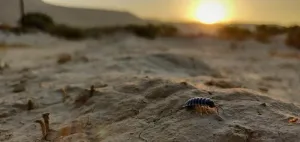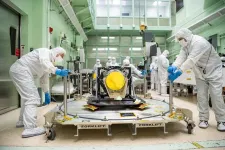(Press-News.org) COVID-19 is here to stay. As restrictions and human testing have waned, new research is tackling the challenge of how we can monitor, predict, and prevent cases and outbreaks of COVID-19, especially among vulnerable groups like hospitalized patients.
One approach is environmental surveillance. The most well-known incarnation is wastewater surveillance, which rose in prominence following the advent of the COVID-19 pandemic. But the Coronavirus in the Urban Built Environment research team, also known as CUBE, is exploring an alternative—swabbing the floors.
In a recent study at two hospitals in Ontario, CUBE researchers swabbed the floors of healthcare worker areas, such as change rooms, meeting rooms and staff washrooms, and observed a strong association between the amount of SARS-CoV-2 viral matter found on the floor and the number of cases and outbreaks of COVID-19 in the hospital.
“The association between floor swabs and human cases and outbreaks was something we had previously observed in long-term care homes, and we wanted to test the hypothesis in the hospital setting,” says Dr. Caroline Nott, Infectious Disease Physician at The Ottawa Hospital, Assistant Professor at the University of Ottawa Department of Medicine, and one of the principal investigators of CUBE.
For every 10-fold increase in the amount of virus detected on the floor, the researchers observed a corresponding 15-fold increase in patient cases and a 22-fold higher odds of a COVID-19 outbreak. These results add to the mounting evidence that floor swabbing may provide an additional layer of monitoring to help inform infection prevention and control measures in hospitals and other settings.
“To be clear, COVID-19 is not spreading via the floor,” reassures Nott. “It is extremely rare to catch COVID-19 from any surface. Rather, what we are seeing in our floor swabs is a reflection of the burden of infection in the humans occupying the environment where we are swabbing. So if we start seeing an increase in the amount of virus we are finding on the floor, it could be a signal that additional cases and potentially outbreaks are on the way. This kind of early warning may help the hospital prepare and take preventative measures.”
But why would the amount of virus on the floor in healthcare worker areas reflect the burden of COVID-19 in the hospital’s patient population?
“Great question,” says Dr. Michael Fralick, Clinician Scientist at Sinai Health, Associate Professor at the University of Toronto, and CUBE principal investigator. “COVID-19 is a respiratory illness. It spreads via droplets and aerosols, which can travel a relatively long distance before falling to the floor.”
Fralick continues, “We focused on healthcare worker areas mainly for pragmatic reasons: those areas are more straightforward to access and do not disrupt direct patient care, which are important considerations if an approach like this were to be implemented.”
The study was conducted over 39 weeks between July 2022 and March 2023, with a total of 760 floor swabs collected. Swabs were processed for SARS-CoV-2 using quantitative reverse-transcriptase polymerase chain reaction. Grouped fivefold cross-validation was used to evaluate model outbreak discrimination. The paper was published last month in Cambridge University Press’s Infection Control and Hospital Epidemiology.
While COVID-19 has fallen out of the public consciousness, building the capacity in our healthcare systems to prevent illness and death in the event of seasonal resurgence and future variants is paramount, says Nott. “We weren’t prepared for COVID-19, and as a result many people died or have suffered long-term effects, especially vulnerable people like those being treated in hospitals or living in long-term care. We are driven to develop methods to prevent similar suffering in future, whether it is a new COVID-19 variant or a different pathogen altogether.”
END
Floor swabbing could help prevent COVID-19 outbreaks in hospitals
In two Ontario hospitals, high levels of SARS-CoV-2 on floors correlated with COVID-19 cases among healthcare workers and patients, suggesting floor swabbing as a potential method to prevent outbreaks
2024-10-22
ELSE PRESS RELEASES FROM THIS DATE:
Paws of polar bears sustaining ice-related injuries in a warming Arctic
2024-10-22
Polar bears in some parts of the high Arctic are developing ice buildup and related injuries to their feet, apparently due to changing sea ice conditions in a warming Arctic. While surveying the health of two polar bear populations, researchers found lacerations, hair loss, ice buildup and skin ulcerations primarily affecting the feet of adult bears as well as other parts of the body. Two bears had ice blocks up to 1 foot (30 centimeters) in diameter stuck to their foot pads, which caused deep, bleeding cuts and made it difficult for them to walk.
The study led by the University of Washington was published Oct. 22 in the journal Ecology. It’s ...
Politics may influence gift-giving choices more than personal purchases
2024-10-22
DURHAM, N.H.—(October 22, 2024)—Political affiliation may not make a difference on everyday purchases for individuals, but it can play a role when buying for friends, family and co-workers, new research from the University of New Hampshire has found. This may have implications for gift buying this holiday season and beyond.
“We performed five different studies, each looking at buying different products, and asked people to make a choice for themselves and then a gift for someone they knew really well and found that politics played a bigger role when people were purchasing gifts, because that's a case where people are making a decision based ...
Listening skills bring human-like touch to robots
2024-10-22
Note to Editors: Video clips available at: https://duke.box.com/s/wtq3ofu3kf84ayw3qr6jajxdizt0rwxc
DURHAM, N.C. – Imagine sitting in a dark movie theater wondering just how much soda is left in your oversized cup. Rather than prying off the cap and looking, you pick up and shake the cup a bit to hear how much ice is inside rattling around, giving you a decent indication of if you’ll need to get a free refill.
Setting the drink back down, you wonder absent-mindedly if the armrest is made of real wood. After ...
Acclaimed WVU doctor and researcher elected to National Academy of Medicine
2024-10-22
A world-renowned West Virginia University physician and researcher has received one of the highest honors in the fields of health and medicine.
Dr. Sally Hodder, director of the West Virginia Clinical and Translational Science Institute, associate vice president for clinical and translational science at WVU and Chancellor’s Preeminent Scholar Chair, was elected to the National Academy of Medicine for her accomplishments as an infectious diseases physician and researcher.
Hodder, the first person from WVU to be chosen for the National Academy of Medicine, is one of only 100 new members from around the world announced at the Oct. 21 NAM ...
New study reveals larger insects' critical role in decomposition in arid ecosystems
2024-10-22
New study reveals that in arid ecosystems, larger arthropods such as termites and beetles play a crucial role in decomposition, challenging the traditional view that microbial activity dominates this process in dry environments. By demonstrating that macro-decomposition can peak during the summer in arid sites and that overall decomposition rates in these regions can be similar to or even exceed those in wetter climates, the research provides new insights into how decomposition functions in drylands and its implications for global carbon ...
NASA reveals prototype telescope for gravitational wave observatory
2024-10-22
NASA has revealed the first look at a full-scale prototype for six telescopes that will enable, in the next decade, the space-based detection of gravitational waves — ripples in space-time caused by merging black holes and other cosmic sources.
The LISA (Laser Interferometer Space Antenna) mission is led by ESA (European Space Agency) in partnership with NASA to detect gravitational waves by using lasers to measure precise distances — down to picometers, or trillionths of a meter — between a trio of spacecraft distributed in a vast configuration larger than the Sun. Each side of the triangular array ...
A new kind of authoritarianism: Democracy in decline at home and abroad
2024-10-22
A majority of Americans worry this year’s general election will be tainted by fraud, according to a recent NPR/PBS News/Marist poll released earlier this month—an ominous indication of the state of democracy in the U.S.
“When citizens lose trust in the electoral process, they may question the legitimacy of elected officials and the institutions they represent, which undermines the foundational principle that government authority is derived from the will of the people,” ...
Performance in physical tests can help manage treatment for metastatic lung cancer
2024-10-22
A study of patients with metastatic lung cancer by researchers based in Brazil and the United States has found that their performance in simple physical tests such as sitting down, standing and walking can help physicians arrive at a prognosis and approach to treatment.
An article on the study is published in the European Journal of Clinical Investigation.
The findings also included identification in the volunteers’ blood plasma of two substances – serine and M22G – with the potential to become biomarkers capable of indicating which patients are most likely to respond to chemotherapy.
The study was supported by FAPESP (projects 16/20187-6 and 19/17009-7), ...
Expanding access to weight-loss drugs could save thousands of lives a year
2024-10-22
New Haven, Conn. — Expanding access to new, highly effective weight-loss medications could prevent more than 40,000 deaths a year in the United States, according to a new study led by researchers at Yale School of Public Health and the University of Florida.
The findings highlight the critical need to remove existing barriers that are hindering people’s access to effective weight loss treatments and impeding public health efforts to address the national obesity crisis, the researchers said. According to the U.S. Centers for Disease Control and Prevention, about 74% of Americans are considered overweight, with about 43% of those individuals ...
Harnessing science to tackle global crises
2024-10-22
In a paper published in PLOS Sustainability and Transformation, an international team of researchers looked at how science could play a more active role in managing crises. The paper builds on the outcomes of the international conference “What Role for Science in Crisis Times? Outlook in the Health, Environment, and Agriculture Interconnected Areas”, held in Montpellier in 2022.
To enhance science’s contribution to crisis management, the paper emphasises the need for interdisciplinarity, where science is integrated across disciplines, and transdisciplinarity, which incorporates various societal actors and stakeholders. By co-designing and co-producing ...
LAST 30 PRESS RELEASES:
Strategic river sensors could have forewarned of Texas Camp flood disaster
Drone sampling of whale breath reveals first evidence of potentially deadly virus in Arctic
Roman soldiers defending Hadrian’s Wall infected by parasites, study finds
Pinochet’s prisoners were tormented with music but still found solace in it, a new book reveals
Fertility remains high in rural Tanzania despite access to family planning
AI-assisted device can improve autism care access
Kinetic careers
Uncovering how parasitic plants avoid attacking themselves to improve crop resistance
Nanoparticle vaccine strategy could protect against Ebola and other deadly filoviruses
Study finds brain care score can predict risk of stroke across racial groups
Key lung immune cells can intensify allergic reactions
Do hormones explain why women experience more gut pain?
New materials conduct ions in solids as easily as in liquids
Breakthrough of the Year: Renewable energy begins to eclipse fossil fuel-based sources
LLM use is reshaping scientific enterprise by increasing output, reducing quality and more
Introducing LightGen, a chip for ultra-fast, ultra-efficient generative AI
Astronomers see fireworks from violent collisions around nearby star
ACC/AHA issue new guideline on managing congenital heart disease in adults
Cosmic crash caught on camera
Is talented youth nurtured the wrong way? New study shows: top performers develop differently than assumed
Ants: An untapped resource in the development of antibiotics?
Archaeologists use AI to create prehistoric video game
Mitochondria migrate toward the cell membrane in response to high glucose levels
Tiny viral switch offers hope against drug-resistant bacteria
Most parents aware of early peanut introduction guidelines, but confused about details
HPV vaccine can protect against severe lesions of the vulva and vagina
Virtual care provision and emergency department use among children and youth
Quadrivalent HPV vaccine and high-grade vulvovaginal lesions
Insights into dry eyes gained from stem cell-derived tear glands
Researchers identify 166 human pluripotent stem cell lines available for use in clinical applications
[Press-News.org] Floor swabbing could help prevent COVID-19 outbreaks in hospitalsIn two Ontario hospitals, high levels of SARS-CoV-2 on floors correlated with COVID-19 cases among healthcare workers and patients, suggesting floor swabbing as a potential method to prevent outbreaks



